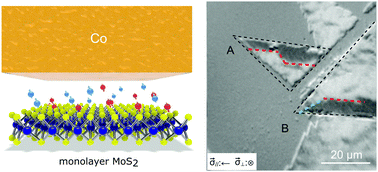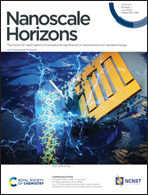Spontaneously induced magnetic anisotropy in an ultrathin Co/MoS2 heterojunction†
Abstract
Magnetic anisotropy (MA) is a material preference that involves magnetization aligned along a specific direction and provides a basis for spintronic devices. Here we report the first observation of strong MA in a cobalt–molybdenum disulfide (Co/MoS2) heterojunction. Element-specific magnetic images recorded with an X-ray photoemission electron microscope (PEEM) reveal that ultrathin Co films, of thickness 5 monolayers (ML) and above, form micrometer (μm)-sized domains on monolayer MoS2 flakes of size tens of μm. Image analysis shows that the magnetization of these Co domains is oriented not randomly but in directions apparently correlated with the crystal structure of the underlying MoS2. Evidence from micro-area X-ray photoelectron spectra (μ-XPS) further indicates that a small amount of charge is donated from cobalt to sulfur upon direct contact between Co and MoS2. As the ferromagnetic behavior found for Co/MoS2 is in sharp contrast with that reported earlier for non-reactive Fe/MoS2, we suggest that orbital hybridization at the interface is what makes Co/MoS2 different. Our report provides micro-magnetic and micro-spectral evidence that consolidates the knowledge required to build functional heterojunctions based on two-dimensional (2D) materials.



 Please wait while we load your content...
Please wait while we load your content...